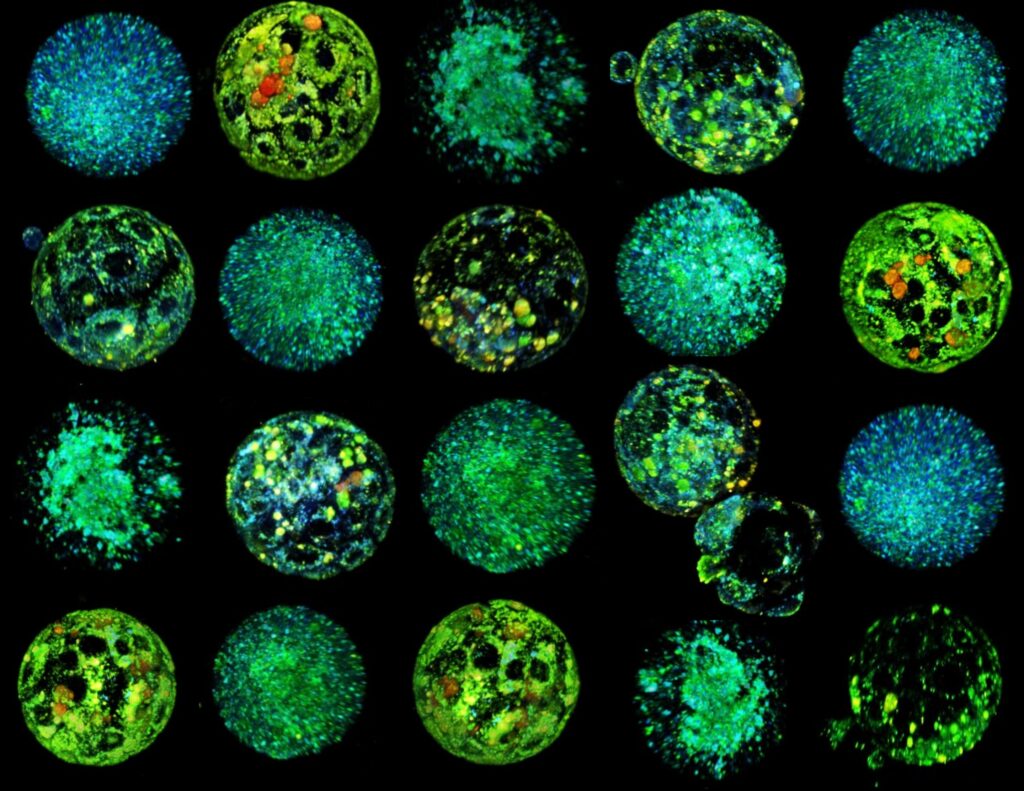3D reconstruction of hyperspectral images of a mouse oocyte and embryo. Courtesy of the Institute of Biotechnology of Catalonia (IBEC).
A new technology developed by the “Biotechnology in Reproductive Health” team at the Catalan Institute of Biotechnology (IBEC) makes it possible to visualize the metabolism of embryos obtained through IVF and determine which embryos are more likely to implant correctly in the uterus and reach full term, a technique that is more precise and reliable than traditional methods.
This groundbreaking method, called “METAPHOR”, produces 3D images that reveal the colours present in the embryo in a completely non-invasive way. As certain naturally fluorescent compounds in the embryo’s metabolism also play an important role in processes such as cellular respiration and nutrient consumption, METAPHOR represents a reliable way to monitor the embryo’s health.
“This new technology will help to increase the success rate of assisted reproductive techniques, reducing the so-called ‘time to pregnancy’ and the financial and psychological burden on patients,” said Samuel Ojos-Negros, principal investigator at IBEC and leader of the study.
A paper published in PNAS describes how, in a study using mice, they were able to double the success rate of selecting viable embryos compared to embryologists using traditional microscopes. In addition to analyzing embryos, the method is also highly accurate in analyzing oocyte metabolism, allowing them to select the most suitable oocytes for in vitro fertilization.
To do this, the researchers compared oocytes from young and older females, since age is known to be crucial for oocyte survival. The METAPHOR system was able to distinguish between young and non-young oocytes with 96% accuracy and predict which oocytes will develop into viable embryos with over 80% accuracy, unprecedented in the field.
3D reconstruction of a mouse embryo. Different colors indicate different metabolisms. Credit: Institute of Biotechnology of Catalonia (IBEC)
“We can assess the decline in egg quality that accompanies age-related decline in fertility. We look for cellular characteristics, so-called ‘molecular signatures’, such as the distribution of mitochondria, that are associated with decreased fertility. From this information, we can predict which oocytes will develop and which will not. This would be a breakthrough in the management of fertility donation and preservation,” says Anna Seriola, senior researcher in the Ojos Negros group and author of the study.
The technological basis of METAPHOR is the use of artificial intelligence methods to analyze metabolic images acquired by hyperspectral microscopy.
“Using hyperspectral microscopy, we obtain hundreds of images containing complex information of many mixed metabolites from embryos and oocytes. To analyze them, we trained artificial intelligence tools that are able to analyze and classify these images in a few minutes,” says Albert Parra, a researcher in the Ojos Negros group and first author of the study.
The power and safety of the new method support METAPHOR as an innovative tool for the physiological evaluation of oocytes and embryos.
The researchers are currently fine-tuning the technique to assess human embryos and have established a spin-off company to introduce the technology into assisted reproduction clinics over the next few years.
More information: Albert Parra et al., “METAPHOR: Metabolic Assessment by Phasor-Based Hyperspectral Imaging and Organelle Recognition in Mouse Blastocysts and Oocytes,” Proceedings of the National Academy of Sciences of the United States of America (2024). DOI: 10.1073/pnas.2315043121. doi.org/10.1073/pnas.2315043121
Courtesy of the Institute of Biotechnology of Catalonia (IBEC)
Citation: New technology visualizes embryo metabolism to improve IVF success (July 1, 2024) Retrieved July 1, 2024 from https://medicalxpress.com/news/2024-07-technology-visualizes-embryo-metabolism-ivf.html
This document is subject to copyright. It may not be reproduced without written permission, except for fair dealing for the purposes of personal study or research. The content is provided for informational purposes only.

